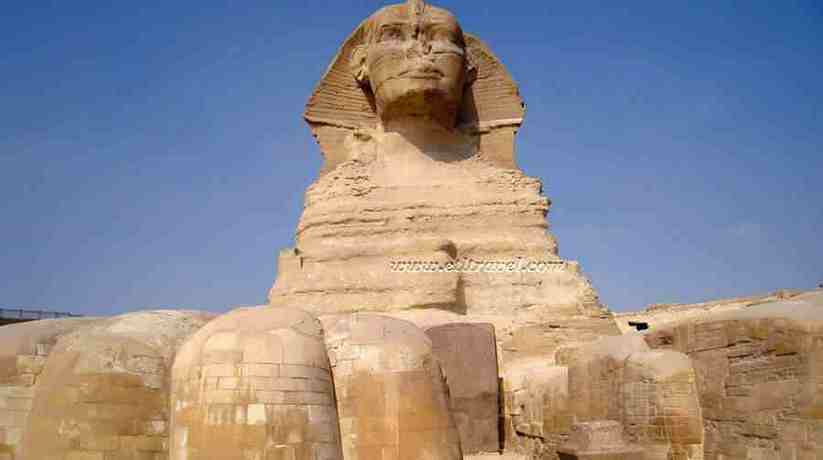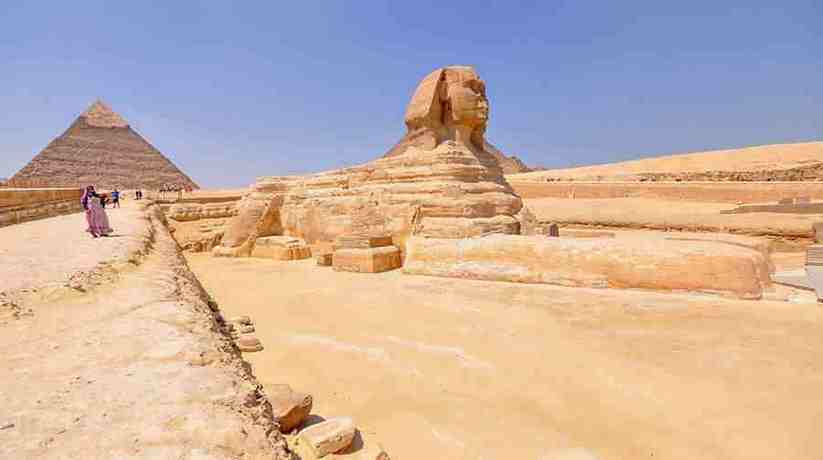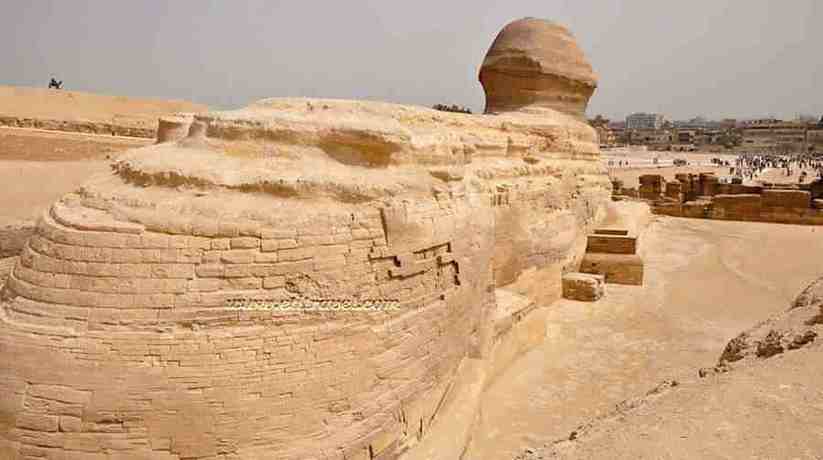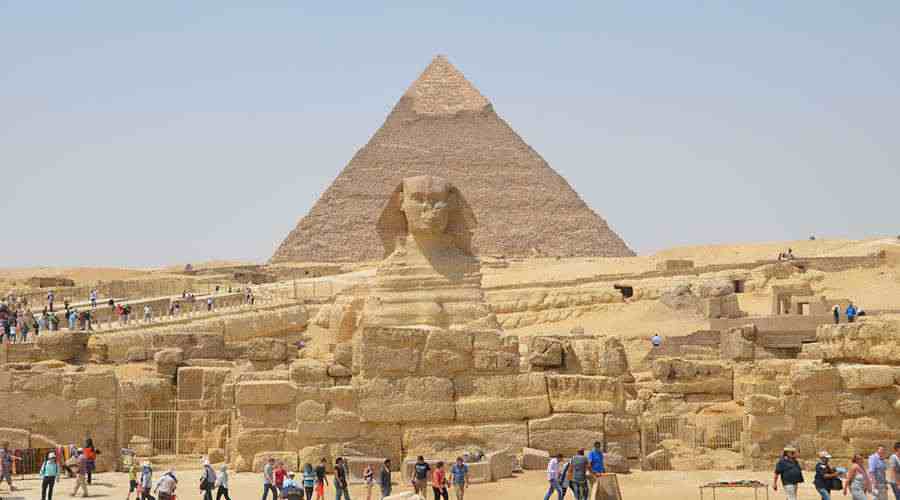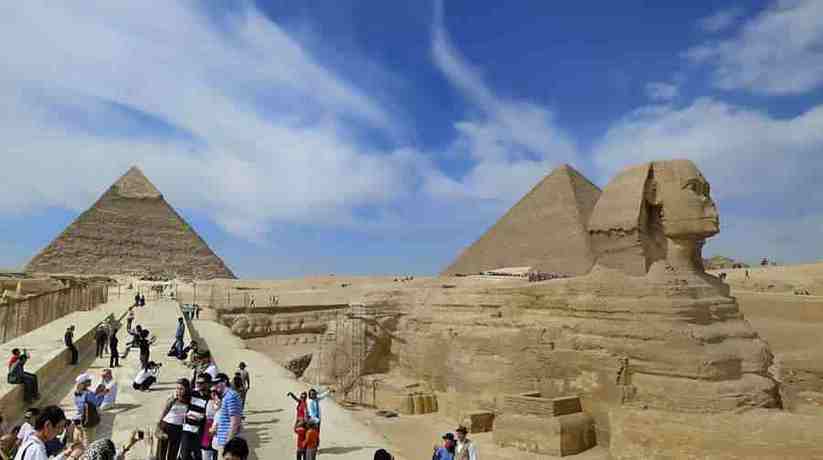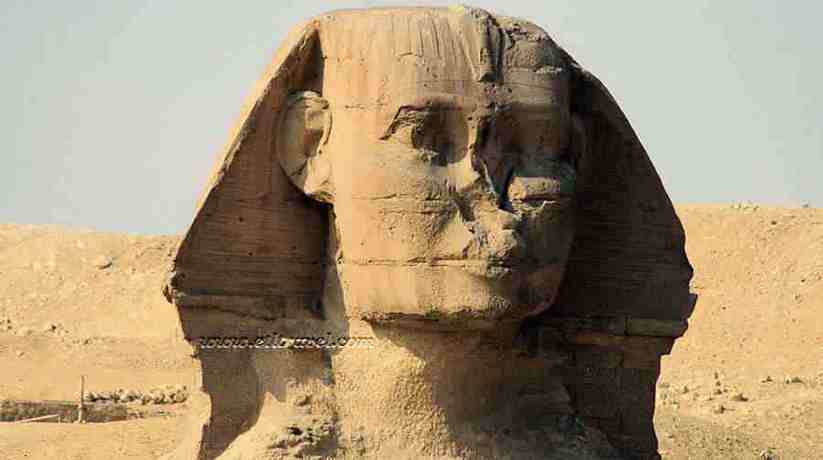Great Sphinx Giza Egypt tours, prices, booking, reviews
Great Sphinx Giza Egypt is a huge creature with the head of a human and a lion’s body. In fact, the Great Sphinx of Giza Egypt sits in a depression. The depression is to the south of Khafre’s pyramid at Giza. The Sphinx statue is the first colossal royal sculpture in Egypt. It is a national symbol of Egypt, both ancient and modern. Moreover, it stirred the imagination of poets, scholars, adventurers and tourists for centuries. It also inspired a wealth of speculation about its age, its meaning, and the secrets that it might hold. The Sphinx word means strangler. It first given by the Greeks to a fabulous creature. It is which had the head of a woman, the body of a lion and the wings of a bird.
In Egypt, there are many sphinxes. They are usually with the head of a king wearing his headdress and the body of a lion. There are sphinxes with ram heads that associated with the god Amun. The Great Sphinx is to the northeast of Khafre’s (Chephren) Valley Temple. It is where it sits was once a quarry. Khafre’s workers shaped the stone into the lion and gave it their king’s face over 4,500 years ago. Khafre’s name also mentioned on the Dream Stele, which sits between the paws of the great beast. No one is certain about the fact the face of Sphinx. Recently, it has argued that Khufu maybe also had the sphinx built. Khufu is the builder of the Great Pyramid.
Further details about the Great Sphinx Giza Egypt:
The sphinx indeed is the most immense stone sculpture which ever made by man. Moreover, it is not an isolated monument. It must examined in the context of its surroundings. The Great Sphinx is a complex which consists of the great statue itself and an old temple. It also consists of a New Kingdom temple and some other small structures. Great Sphinx related to Khafre’s Valley Temple. Khafre’s Valley itself had four colossal sphinx statues. Each is more than 26 feet long. The material of the sphinx is the limestone bedrock. It is of what geologists call the Muqqatam Formation. Moreover, it originated fifty million years ago. It is from sediments which deposited at the bottom of sea waters.
An embankment formed along what is now the north-northwest side of the plateau. Nummulites are small and disk-shaped fossils. They named after the Latin word for ‘coin’, pack the embankment. These were once the shells of now extinct plank-tonic organisms. There was a shoal and coral reef that grew over the southern slope of the embankment. The ancient Egyptians built the sphinx from Carbonate mud. It deposited in the lagoon petrified into the layers fifty million years ago. They trenched out a deep, U-shaped ditch. This is to isolate a huge rectangular bedrock block for carving the Sphinx. This enclosure is deepest immediately around the body. It is with a shelf at the rear of the monument. It left unfinished. A shallower extension to the north where important archaeological finds have made.
More details about Giza Sphinx:
There are hard limestone lays around the Sphinx’s head. It was all quarried for blocks to build the pyramids. The limestone removed to shape the body of the beast. It employed to build the two temples to the east of the sphinx. There is one in front of the paws. The other to the south of the first one. They are on a terrace lower than the floor of the Great Sphinx of Giza Egypt enclosure. The quarrying around the original knoll revealed rock. It was too poor in quality for construction. Some visionary individual conceived of the plan to turn what left of the knoll into the Sphinx. The Sphinx may well have planned from the start for this location, good rock or bad. The walls of the sphinx enclosure are of the same characteristics.
The strata of the sphinx body and exhibit similar states of erosion. The bedrock body of the Sphinx became a standing section of the deeper limestone layers of Giza Plateau. The lowest stratum of the Great Sphinx of Giza Egypt is the hard and brittle rock of the ancient reef. It referred as Member I. All the geological layers slope about three degrees from northwest to southeast. They are higher at the rump of the Sphinx and lower at the front paws. The surface of this area has not weathered compared to the layers above it. Most of the Sphinx’s lion body carved into the Member II. The body parts are the south wall and the upper part of the ditch. It consists of seven layers. They are soft near the bottom and harder near the top. The rock actually alternates between hard and soft.
Further details about Great Sphinx in Cairo, Egypt:
The head and neck of the sphinx made of Member III. It is better stone, though it becomes harder further up. The Great Sphinx of Giza Egypt faces the rising sun with a temple to the front. It resembles the sun temples which built later by the kings of the 5th Dynasty. The lion was a solar symbol in more than one ancient Near Eastern culture. The royal human head on a lion’s body symbolized power. It controlled by the intelligence of the pharaoh or ma’at. Its symbolism survived for 2500 years in the iconography of Egyptian civilization. The head and face of the sphinx reflect a style that belongs to Egypt’s Old Kingdom.
The form of the Great Sphinx face is broad. It is almost square with a broad chin. The headdress has fold over the top of the head. It has triangular planes behind the ears. Moreover, it has presence of the royal ‘uraeus’ cobra on the brow. It also has treatment of the eyes and lips. They are all evidences that the Great Sphinx of Giza Egypt carved during this period. The sculptures of kings Djedefre, Khafre and Menkaure show the same configuration on the Sphinx. Some scholars believe that the sphinx bearded with the sort of plaited beard. Pieces of the Sphinx’s massive beard adorn the British Museum in London. They are also in the Egyptian Museum in Cairo. The rounded divine beard is an innovation of the New Kingdom.
More details about The Great Sphinx of Giza:
According to Rainer Stadelmann, did not exist in the Old or Middle Kingdom. It may have added to identify the god with Horemahket. There is a hole in the top of the head. It now filled in. It once provided support for extra head decoration. The top of the head is flatter than later Egyptian sphinxes. The body of the sphinx is 72.55 meters in length and 20.22 meters tall. The face of the Great Sphinx of Giza Egypt is four meters wide and its eyes are two meters high. The mouth is about two meters wide. The nose would have been more than 1.5 meters long. The ears are well over one meter high. Part of the Uraeus (sacred cobra), the nose, the lower ear and the ritual beard are now missing. The eyes have pecked out.
Below the neck, the Great Sphinx has the body of a lion, with paws, claws and tail. The tail curled round the right haunch. It sit on the bedrock of the rocky enclosure out of which the monument has carved. The enclosure has taller walls to the west and south of the monument. It keeps with the present lie of the land. When viewed close-up, the head and body of the Sphinx look well proportioned. Seeing from further away and side-on the head looks small in relation to the long body. In its undamaged state, the body is likely to have appeared still larger all around. It is in relation to the head which has not reduced as much by erosion. The human head is on a scale of about 30:1. The lion body is on the smaller scale of 22:1. There could be many of explanations for this discrepancy.
Further details about The Great Sphinx Egypt:
The sphinx maybe sculpted to look its best when seen from close by. It is while and more or less from the front. There is also the possibility that there was insufficient good rock to make the head. The fissure at the rear of the Great Sphinx maybe dictated a longer body, rather than one much too short. There are three passages into or under the Sphinx, two of them are of obscure origin. The one of known cause is a short dead-end shaft behind the head drilled in the nineteenth century. No other tunnels or chambers in or under the Sphinx known to exist. Many small holes in the Sphinx body may relate to scaffolding at the time of carving. The figure buried for most of its life in the sand.
It was King Thutmose IV (1425 – 1417 BC) who placed a Stela between the front paws of the figure. On it, Thutmose describes an event, while he was still a prince. He went for hunting and fell asleep in the shade of the sphinx. During a dream, the sphinx spoke to Thutmose and told him to clear away the sand. The sphinx told him that if he did this, he would rewarded with the kingship of Egypt. Thutmose carried out this request and the sphinx held up his end of the bargain. Of course, over time, the Great Sphinx of Giza Egypt found itself buried beneath the sand. When Napoleon arrived in Egypt in 1798, the sphinx buried once more with sand up to its neck. The nose had been missing for at least 400 years.
Further details about the Great Sphinx of Giza Egypt:
Between 1816 and 1817, the Genoese merchant, Caviglia tried to clear away the sand. He only managed to dig a trench down the chest of the statue and along the length of the fore-paws. Auguste Mariette is the founder of the Egyptian Museum in Cairo. He also attempted to excavate the Sphinx. Moreover, he gave up in frustration over the enormous amount of sand. He went on to explore the Khafre Valley Temple. Furthermore, he returned to the Great Sphinx to excavate in 1858. Between 1925 and 1936, French engineer Emile Baraize excavated the Sphinx. It was behalf of the Antiquities Service. The great beast once again became exposed to the elements. In fact, the sand has been its savior. It is since built of soft sandstone. The Great Sphinx of Giza Egypt crumbles today because of the wind, humidity and the smog from Cairo.
The rock was of poor quality here from the start. It fissures along joint lines and dated back to the formation of the limestone millions years ago. There is a particularly large fissure across the haunches. It nowadays filled with cement. Moreover, it also shows up in the walls of the enclosure. It is in where the Sphinx sits. Below the head, serious natural erosion begins. The neck weathered by wind-blown sand. The stone here is not quite of such good quality as that of the head above. Erosion below the neck does not look like scouring by wind-blown sand. In fact, so poor is the rock of the bulk of the body. It deteriorated since the day it carved out of the stone. In fact, it needed repairs on more than one occasion in antiquity. Today, there is much of the work on the Great Sphinx.

